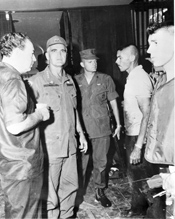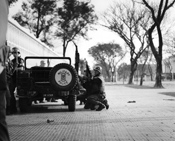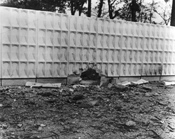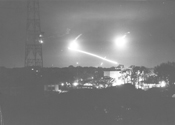- Exhibits
- Tet Offensive
- Saigon
- American Embassy
The Tet Offensive (Tết Mậu Thân)
- The Tet Offensive (Tết Mậu Thân)
- Hue: The Imperial City
- The Battle of Khe Sanh
- The Battle for Saigon
- Aftermath of the BattlesPolitical ConsequencesExhibit Credits
The American Embassy

AVSG-S-1031-20-/AGA68 RVN Saigon Gen. William C. Westmoreland talks to military personnel in the U.S. Embassy after an unsuccessful Viet Cong siege. 31 Jan. 1968 Photo by: SP5 Edgar Price Pictorial A.V. Plt. 69th Sig. Bn. (A)
(Donald Jellema Collection (Department of the Army Special Photographic Office (DASPO)) [va030823])The North Vietnamese chose the new American embassy building as one of their few US targets, hoping to embarrass the Americans enough in this action to drive them out of the war entirely. Members of the C-10 Sapper Battalion arrived outside the embassy at 2:47 a.m., and quickly blew a hole in the outer wall. They intended to enter the embassy grounds and then force their way into the Chancery building.
Fortunately, MPs guarding the inside gate fired on the invading sappers, killing several of them before being killed themselves. This quick defense gave the Americans two advantages: one, it allowed the Marines inside the Chancery to secure the doors against attack and, two, it killed the sapper battalion’s leaders. After the loss of their leaders, the sappers could not coordinate their activities and take the embassy, despite their superior weapons and rockets. Once the MP reinforcements arrived outside, the sappers were trapped on the grounds.
Now in other parts of Saigon, down in Cholon area and so on, fighting was still going on. But Saigon was safe and secure at that time in that area where the embassy was, Gia Long Palace was and many of the government installations were but you would never know it from the coverage that emerged. CBS ran raw tape, unedited tape, of the early part of that fighting. It looked as if all of Saigon was going up in flames. It simply was not. Was it a good situation? No. But again I say the picture’s gray, not black and white. Enough.
- Barry Zorthian [Oral History #OH0540], Transcript page 125 lines 19 – 25.
(complete interview; transcript; more information)Over the next six hours the American MPs and Marines guarding the embassy engaged the sappers, eventually cornering the final man inside a house on the embassy grounds. The house’s inhabitant, Col. George D. Jacobson worked with the MPs to kill the final sapper and end the battle, only one sapper was captured alive.
As the North Vietnamese hoped, the embassy battle had a huge impact on the American people’s opinion of the war. Many of the reporters in Saigon flocked to the embassy, incorrectly reporting that the VC had taken the Chancery building. This news, combined with footage showing a shootout with numerous casualties on the embassy lawn, shocked the American people, who just months earlier had been told by General Westmoreland that the war was nearly won. Shortly after the battle, Westmoreland arrived at the embassy to congratulate the defenders and tell the American people of yet another American victory. Unfortunately, this speech when shown next to footage of the numerous bloody battles of the Tet Offensive throughout South Vietnam only served to turn the American people against the war and Westmoreland.

cc 45769 Saigon Republic of Vietnam. Viet Cong Attack American Embassy Members of the 716th MP Bn guard the entrance to the embassy....
(Peter Braestrup Collection [va035387])
AVSG-S-1031-24/AGA68 RVN Saigon The hole in the embassy wall through which Viet Cong commandos attacked the U.S. Embassy....
(Donald Jellema Collection (Department of the Army Special Photographic Office (DASPO)) [va030805])
Vietnam Center & Sam Johnson Vietnam Archive
-
Address
Texas Tech University, Box 41041, Lubbock, TX 79409 -
Phone
(806)742-9010 -
Email
vnca@ttu.edu


